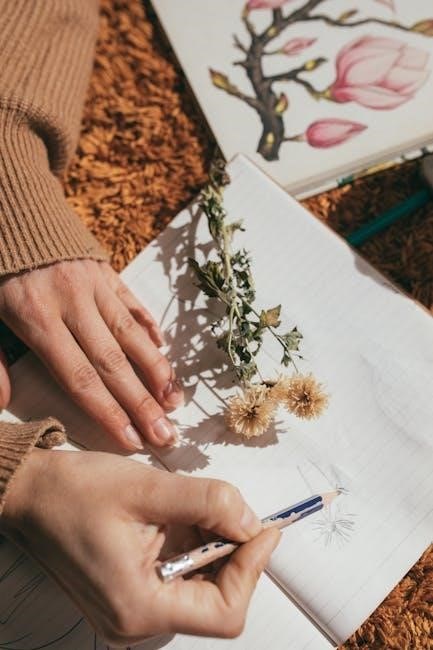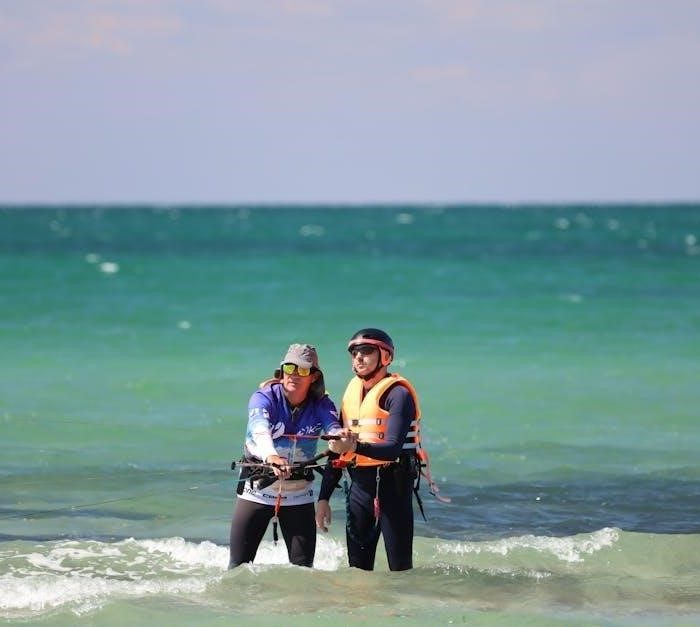A comprehensive guide to nature drawing and journaling, offering fundamental techniques, step-by-step demonstrations, and blending art, science, and enthusiasm. Perfect for both beginners and experienced journalers, fostering creativity and a deeper connection with nature.
What is Nature Journaling?
Nature journaling is a practice that combines artistic expression and scientific observation to document experiences in the natural world. It involves sketching, writing, and recording details about ecosystems, wildlife, and landscapes. This method encourages mindfulness, curiosity, and a deeper connection with the environment. Ideal for all skill levels, nature journaling blends creativity with education, making it a versatile tool for both personal growth and environmental awareness. By capturing observations, it fosters a sense of stewardship and appreciation for nature’s beauty and complexity. The Laws Guide to Nature Drawing and Journaling provides practical advice and inspiration for those seeking to explore this rewarding practice.
Benefits of Combining Drawing and Journaling
Combining drawing and journaling enhances creativity, observation skills, and personal growth. It allows individuals to document their experiences while fostering a deeper connection with nature. This practice sharpens attention to detail and encourages a more mindful interaction with the environment. By blending art and science, it provides a holistic approach to learning and self-expression. The Laws Guide emphasizes how this synergy can lead to improved focus, stress relief, and a sense of accomplishment. Moreover, it serves as a valuable tool for environmental education, promoting a greater appreciation for the natural world and its intricate details.

Essential Techniques for Nature Drawing
Mastering observation, sketching, and color theory are fundamental. Techniques include contour drawing, shading, and capturing textures to accurately represent natural forms and scenes effectively in journals.
Observation Skills for Accurate Representation
Developing keen observation skills is crucial for capturing nature accurately. Start by slowing down and truly seeing your subject, noting details like shape, texture, and posture. Practice contour drawing to outline forms precisely. Pay attention to negative space and how elements interact within a scene. Train your eyes to discern subtle variations in color, tone, and patterns. Understanding the structure of plants and animals will help you depict them more realistically. Break subjects into simple shapes and lines to build accurate compositions. Over time, these practices will refine your ability to observe and render nature faithfully, enhancing both your art and connection to the natural world.
Understanding Color Theory in Nature
Color theory is a cornerstone of nature drawing, helping artists capture the vibrancy and subtlety of the natural world. By studying the color wheel, you can identify complementary and analogous colors, enhancing your ability to mix pigments accurately. Nature often features warm and cool color contrasts, such as the golden hues of sunlight against the cool greens of foliage. Understanding how light interacts with colors is essential for realistic depictions. Practice observing the way colors change with the time of day and season. Using tools like a color wheel can guide your palette choices. This knowledge allows for more authentic and visually striking representations of nature in your journal, bridging art and science seamlessly.
Tools and Materials for Nature Drawing
Equipping yourself with the right tools is essential for nature drawing. Start with a sturdy, portable sketchbook made of high-quality, acid-free paper. Pencils are a cornerstone, with graphite pencils (HB, 2B, 4B, 6B) offering versatility for detail and shading. Erasers, like kneaded and white vinegar, are indispensable for corrections. Colored pencils or watercolors add vibrancy, capturing nature’s hues. A sharpener and blending stumps enhance precision and smooth transitions. Consider a compact set of waterproof pens for bold lines. Natural brushes or sponges can create textured effects. Store these tools in a durable, organized bag for easy access. Choosing materials that balance quality and portability ensures a seamless and enjoyable nature journaling experience, whether in a backyard or wilderness setting.
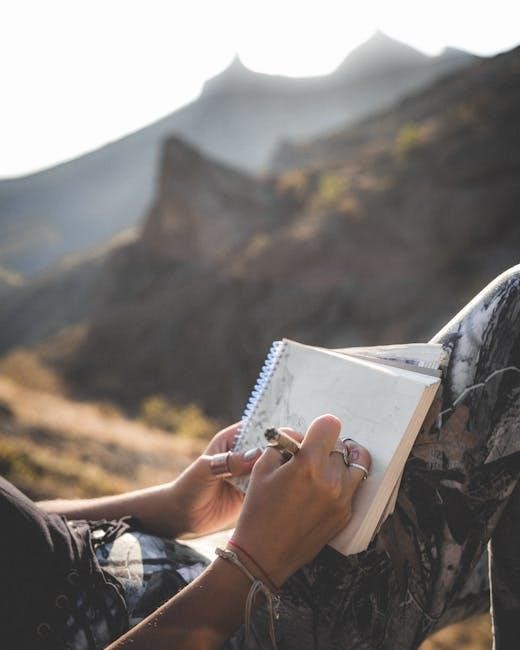
Effective Journaling Practices
Combine observation, documentation, and reflection to enhance creativity and personal growth. Record ecosystems, note seasonal changes, and reflect on experiences to deepen your connection with nature.
Writing Techniques for Nature Journaling
Effective journaling begins with clear, concise writing that captures observations and insights. Use descriptive language to document weather, species, and habitats. Include sketches and notes to enhance entries.
Incorporate sensory details—sights, sounds, smells—to bring journals to life. Reflect on personal experiences and emotions, adding depth to your recordings. Practice consistency by dating and titling entries.
Combine scientific accuracy with creative expression, ensuring entries are both informative and engaging. This approach fosters a deeper connection with nature and improves observational skills over time.
Incorporating Scientific Observations
Nature journaling thrives when art and science converge. Observing and recording natural phenomena with precision enhances the journal’s educational value. Note weather patterns, animal behaviors, and plant characteristics, ensuring accuracy for future reference.
Use techniques like measurement, classification, and comparison to add depth. Sketch diagrams of ecosystems or life cycles, and include quick sketches of specimens. These practices bridge creativity with scientific rigor.
Documenting habitats and seasonal changes provides insights into environmental interactions. By blending artistic expression with observational science, journals become invaluable tools for learning and conservation, fostering a deeper appreciation of nature’s complexity.
Reflection and Personal Growth Through Journaling
Nature journaling is not just about documenting observations; it is a powerful tool for personal growth and self-reflection. By immersing yourself in nature and capturing its beauty, you cultivate mindfulness and a deeper connection to the world around you.
Reflecting on your journal entries over time reveals patterns in your thoughts, artistic progress, and emotional journey. This practice encourages introspection, helping you identify personal strengths and areas for growth.
The process of journaling also fosters gratitude and humility, as you appreciate nature’s complexity and your place within it. It becomes a therapeutic outlet, blending creativity with self-discovery, and inspiring a lifelong commitment to learning and exploration.
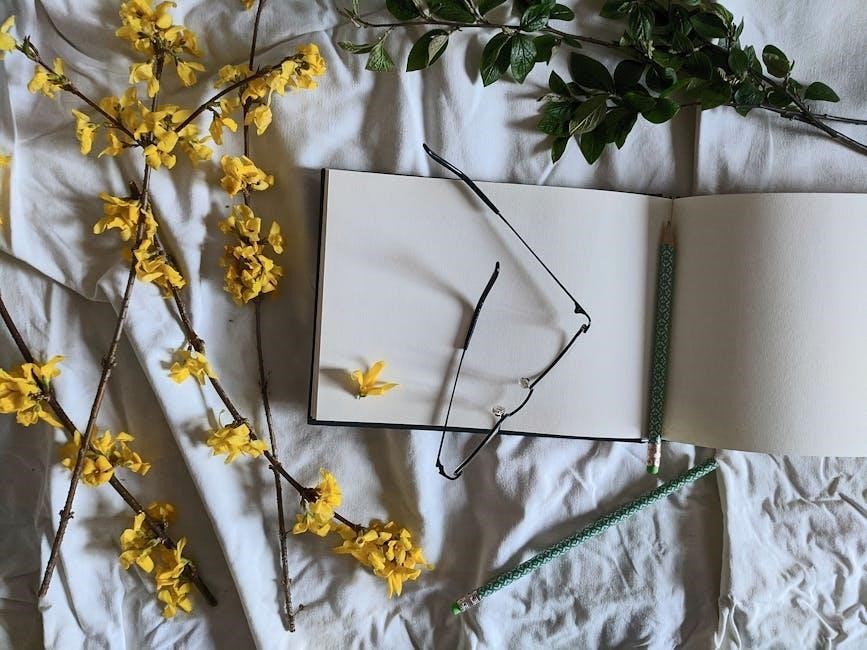
Combining Art and Science
Nature journaling seamlessly merges artistic expression with scientific observation, enhancing both creative and analytical skills through detailed documentation and a deeper understanding of natural phenomena.
The Role of Scientific Accuracy in Drawings
Scientific accuracy in nature drawing is crucial for capturing the essence of the natural world. It ensures that illustrations are not only aesthetically pleasing but also informative and precise. Observation and attention to detail are key, as they help in accurately representing the subject’s form, texture, and color. The Laws Guide emphasizes the importance of understanding the subject’s structure, whether it’s the anatomy of a leaf or the plumage of a bird. This approach bridges the gap between art and science, allowing the artist to create drawings that are both visually appealing and educationally valuable. By prioritizing accuracy, nature journalers can deepen their connection with the natural world and create a reliable record of their observations.
Documenting Ecosystems Through Journaling
Documenting ecosystems through journaling is a powerful way to capture the intricate interactions within nature. By combining detailed sketches with annotated notes, journalers can record the relationships between species, habitats, and environmental conditions. The Laws Guide to Nature Drawing and Journaling provides techniques for observing and illustrating these connections. This practice not only enhances observational skills but also fosters a deeper appreciation for the interconnectedness of life. Over time, these records become a valuable repository of ecological knowledge, allowing journalers to track changes and patterns in the natural world. Such documentation also serves as a tool for conservation and education, inspiring stewardship of the environment.

Inspiration and Creativity
Nature journaling ignites creativity by fostering curiosity and artistry. Observing and drawing the natural world sparks imagination, encouraging unique perspectives and creative expression through art and words.
Finding Inspiration in Nature
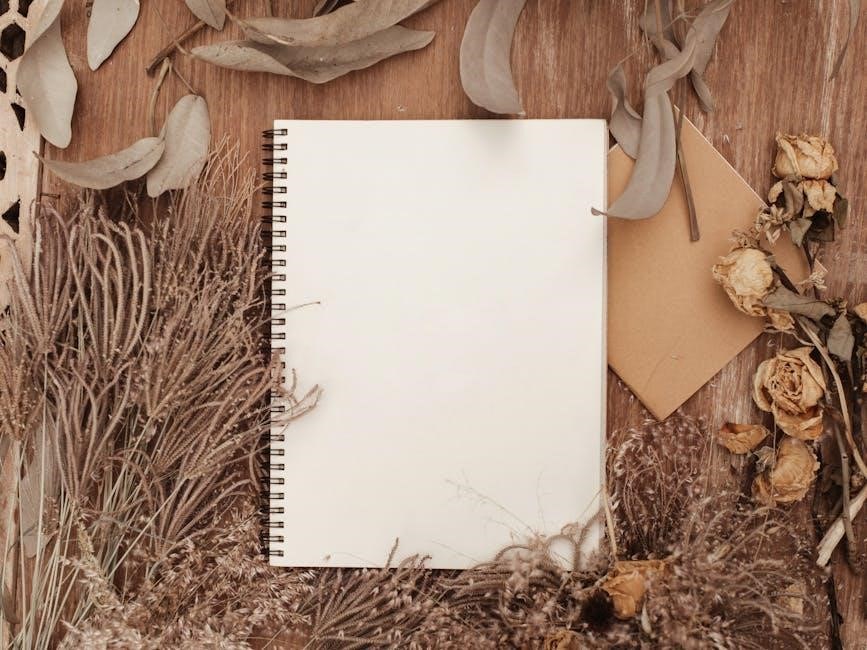
Nature journaling is a powerful way to connect with the environment, fostering inspiration through observation and creativity. By immersing oneself in natural settings, individuals can draw inspiration from the intricate details of plants, animals, and landscapes. The Laws Guide emphasizes the importance of slowing down and truly seeing the world around us. This practice encourages a deeper appreciation for nature’s beauty and complexity. Inspiration can be found in the patterns of leaves, the colors of sunsets, or the behaviors of wildlife. Journaling these observations not only enhances creativity but also serves as a meaningful way to document and reflect on natural experiences. Over time, this practice cultivates a greater sense of wonder and connection to the world.
Exploring Different Art Styles
Nature journaling offers the freedom to experiment with various art styles, allowing individuals to express their observations creatively. The Laws Guide encourages exploring techniques like detailed realism, impressionistic sketches, or minimalist interpretations of natural subjects. By experimenting with different styles, journalers can discover what resonates most with their personal vision and skill level. This creative exploration not only enhances artistic growth but also makes journal entries more engaging and reflective of the artist’s unique perspective. Whether focusing on intricate botanical drawings or loose, expressive landscapes, the guide provides practical tips for mastering these styles and adapting them to individual preferences, ensuring a fulfilling and evolving journaling practice.
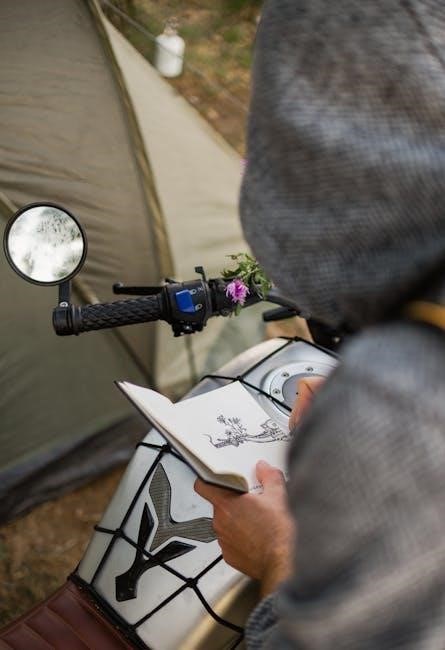
The Impact of Nature Journaling
Nature journaling fosters creativity, enhances observation skills, and deepens one’s connection with the natural world, promoting mindfulness and a greater appreciation for environmental beauty and complexity.
Enhancing Creativity and Observation Skills
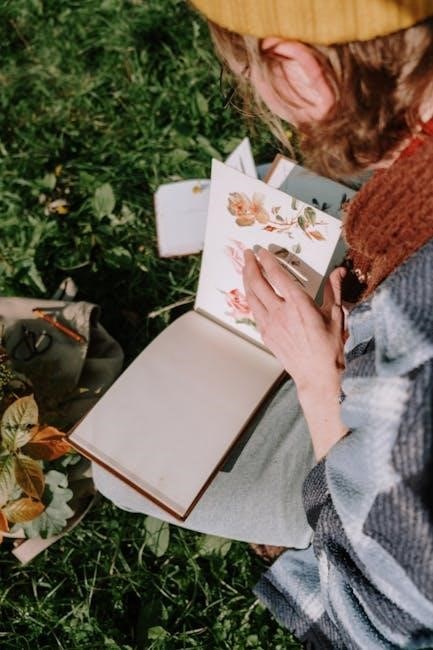
Nature journaling is a powerful tool for enhancing creativity and observation skills, encouraging individuals to slow down and truly notice the intricate details of the natural world. By combining art and science, journaling helps develop a keen eye for patterns, textures, and colors in nature. The process fosters creativity as participants experiment with different drawing techniques and ways to express their observations. Over time, these practices refine artistic abilities and deepen one’s connection to the environment. The guide provides practical tips and step-by-step instructions, making it accessible for all skill levels to improve their observational and creative capacities through nature journaling.
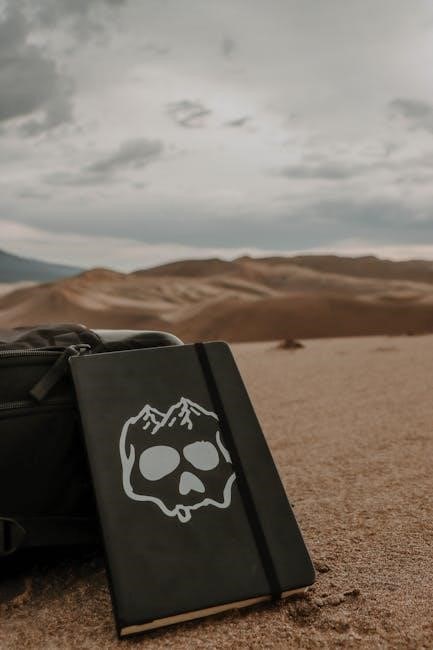
Deepening Connection with the Natural World
Nature journaling fosters a profound connection with the natural world by encouraging mindfulness and immersion in outdoor environments. The process of observing, drawing, and writing about nature helps individuals develop a deeper appreciation for its beauty and complexity. By slowing down to record details, journalers often discover new species, patterns, and ecosystems they might otherwise overlook. This practice cultivates a sense of stewardship and responsibility toward the environment. The guide provides practical tips for engaging with nature meaningfully, helping readers build a lasting emotional and intellectual bond with the world around them. Over time, this connection can inspire a lifelong passion for nature and conservation.
